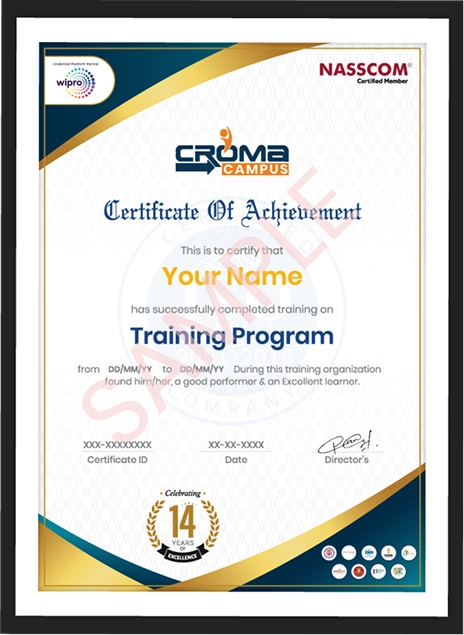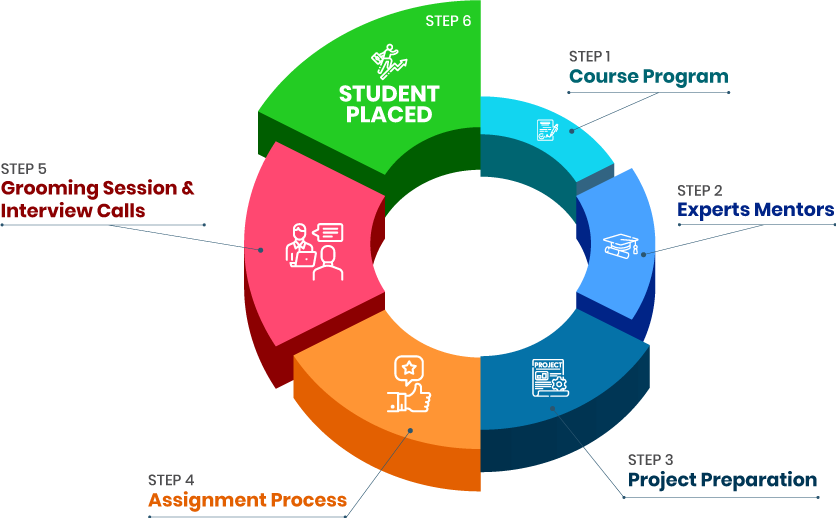Course Design By
Nasscom & Wipro
The Data Analytics Online Course teaches you both fundamentals and hands-on skills.
Learn how to clean and sort data, and present it in easy-to-understand simple charts.
Develop experience with both small and large sets of data.
Get trained in the best tools and techniques used by companies today in Data Analysis Online Training.
Implementation of data collection, cleaning, and preparation concepts
Usage of visualization techniques for the delivery of data-driven narratives
Usage of statistical models for hypothesis testing in business
Application of machine learning algorithms in predictive modeling
Development of SQL queries for real-time data management
Development of dashboards using BI tools for real-time reporting
Microsoft Excel (formulas, pivot tables, lookups, VBA): Excel is not merely for creating tables-it's a powerhouse function to calculate, sort, and consolidate data at lightning speed. With advanced formulas, pivot tables, and lookups, you can easily retrieve answers from massive sheets.
SQL (querying, joins, stored procedures, subqueries): SQL is almost a database query language. It assists you to ask questions to huge data storage systems, such as "display all Delhi sales last month." Joins, subqueries, and procedures enable you to get tricky information in seconds.
Python (NumPy, Pandas, Matplotlib, Scikit-learn): Python is a good beginning language employed in the majority of data analytics tasks. Libraries such as NumPy and Pandas are used in data cleaning and preparation, Matplotlib for plotting charts, and Scikit-learn for predictive model building.
R Programming (statistical testing, regression, data cleaning): R is primarily for data science and statistics. It allows one to test hypotheses, perform regression (discover the correlation between data), and sanitize dirty data. It's essentially a calculator, but specifically made for data scientists.
Power BI (DAX, data modeling, interactive dashboards: Power BI is a Microsoft tool that turns business data into clear information. Power BI generates interactive dashboards and visualization reports. Through DAX formulas and data modeling, you can link various sources of information and make sense of them all.
Tableau (stories, dashboards, filters, calculated fields: Tableau is a data visualization platform that makes data pretty, interactive dashboards, and charts. You can filter, make calculations, and even "tell data stories" to reveal insights in plain words.
Google Analytics (conversions, behavior analysis, web traffic): Google Analytics is employed to monitor what occurs on websites. It provides feedback on the number of visitors who arrive, where they arrive from, what they click, and whether or not they buy something (convert). This assists businesses with making their websites and advertisements better.
Hadoop & Spark (processing big data): Hadoop and Spark are similar to giant engines to run the enormous amount of data that do not fit in regular computers. They execute data in many machines simultaneously, which is why they are very significant for big companies possessing huge data.
Data cleaning and preprocessing techniques: Prior to analysis, data is often dirty with errors, redundancy, or missing information. Cleaning and preprocessing is akin to washing and sorting raw ingredients prior to preparing the food-it prepares the data for hard-hitting insights.
SQL coding and database tuning: SQL assists in communication with the database, but coding it efficiently and database tuning accelerates data fetching. It is comparable to alphabetizing a library so that you can quickly grab the right book rather than digging through it.
Exploratory Data Analysis (EDA): EDA is the initial deep examination of data. It refers to verifying patterns, trends, and unusual values in order to learn what is happening. Consider it as "getting acquainted with your data" prior to making decisions.
Data visualization using BI tools: Visualization transforms dull numbers into beautiful charts and dashboards. BI software such as Tableau or Power BI enables one to easily communicate detailed data to anyone-even non-technical persons.
Statistical hypothesis testing: It's used to test whether your hypotheses regarding data are correct. For instance, "Do men shop online more than women" Hypothesis testing confirms or rejects such notions with real data.
Machine learning predictive modeling: All about getting computers to predict the future based on the past. For instance, predicting churn of customers or stock price. It's like providing the system with a "crystal ball" fueled by math.
Python/Pandas data wrangling: Data wrangling is cleaning, joining, or reshaping data into the correct format. Using Python's Pandas library, data analysts can organize dirty data and make it clean to analyze.
Big Data processing using Spark/Hadoop: When data is too large to process with regular tools, Hadoop and Spark come into play. They slice the massive data into manageable pieces, process the data within many machines, and gather results-similar to a team process to tackle big issues.
Fourier transformations for industry-special data: This is a mathematical method employed in telecommunication, engineering, or audio processing. It is useful in breaking down complicated signals (such as sound waves or sensor outputs) into simpler signals for analysis.
Product and marketing analytics A/B testing strategies: A/B testing tests two versions of an ad or a product (Version A and Version B) to determine which one is best. It is similar to testing two recipes among a group of individuals to determine which one they like best.
Introduction to Data Analytics: Business analytics concepts, business relevance
Analysts & SQL & Excel: SQL queries, joins, pivots, functions, automation
Probability & Statistics: Hypothesis testing, regression, sampling
Data Analytics & Python: Data wrangling, visualization, machine learning libraries
R Programming: Statistical modeling, simulation-based statistics
Business Intelligence Tools: Tableau & Power BI dashboards, reporting
Big Data Analytics: Hadoop, Spark introduction, handling humongous datasets
Advanced Analytics: A/B testing, predictive analytics, case studies
Capstone Project: Live project reflection of industry problem-solving
Data Analyst Course India Completion Certificate
Microsoft Power BI Certification (optional with module)
Tableau Desktop Specialist Certification support
Google Analytics Individual Qualification (GAIQ) guide
Python for Data Science certification support
SQL Advanced Queries Certificate
Capstone Project Industry Certification
Data Analyst
Business Intelligence Analyst
SQL Data Analyst
Marketing Data Analyst
Financial Data Analyst
Machine Learning Associate
Junior Data Scientist
MIS Reporting Analyst
Web Data Analyst
Risk Analyst
Entry Level (0 to 2 years): Job is Data Analyst or MIS Analyst with a mean pay of 4.5 to 6.5 LPA.
Mid Level (2 to 5 years): Job like BI Analyst or Web Analyst gets about 7 to 12 LPA.
Experienced (5+ years): Senior Data Analyst or Data Scientist may anticipate 15 to 22 LPA.
Advanced Expertise: Analytics Manager or AI/ML Specialist may provide 25+ LPA.
Junior Data Analyst - Data Analyst - Senior Data Analyst - Business Intelligence Specialist - Data Scientist - Analytics Manager - Chief Data Officer
Every profession in data analytics has deliverables. Assignments typically consist of data preparation, reporting, analysis, and recommendations. Along the process, the following titles can be accepted by professionals after Data Analytics Certification.
Capturing ordered and unordered collections of data from various sources
Data cleaning, transformation, and validation for accuracy
Composing SQL queries to analyze data and manage databases
Creating interactive dashboards and reports using BI tools
Applying statistical models to identify patterns and make predictions
Facilitating business decisions through data analysis
Reporting back findings with technical stakeholders and non-technical managers
Interfacing with big data software for mass-scale analysis
A/B testing of sales/marketing metrics
Information Technology & Software Services
Finance & Banking
Healthcare and Life Sciences
E-commerce and Retail
Telecommunications
Manufacturing & Supply Chain
Media and Entertainment
Consulting and Market Research Companies
Logistics and Transportation
Energy and Utilities
we train you to get hired.

By registering here, I agree to Croma Campus Terms & Conditions and Privacy Policy
+ More Lessons
Course Design By
Nasscom & Wipro
Course Offered By
Croma Campus
Stories
success
inspiration
career upgrade
career upgrade
career upgrade
career upgrade
You will get certificate after
completion of program
You will get certificate after
completion of program
You will get certificate after
completion of program
in Collaboration with

Empowering Learning Through Real Experiences and Innovation
we train you to get hired.
Phone (For Voice Call):
+91-971 152 6942WhatsApp (For Call & Chat):
+91-971 152 6942Get a peek through the entire curriculum designed that ensures Placement Guidance
Course Design By
Course Offered By
Ready to streamline Your Process? Submit Your batch request today!
Croma campus is one of the best institute for training of IT professional jobs. It is one of the most prestigious and certified organizations that has been associated with the top most MNCs. Croma campus is situated in Noida which is really famous for its innovative and technical teaching methods. So, if you want to get linked with Data Analytics then do a Collab with Croma Campus.
Data Analytics is a process of examining datasets to know about the information they contain. There are a lot of works and jobs under Data Analytics. The first thing you need to do is to always keep your profile updated on LinkedIn because they are directly associated with Data Analytics. So, if you get an Data Analytics certificate you can work as Data Analyst.
Data Analytics is nowadays becoming a very important certification that can lead you to get a good job. To get any Data Analyst job you need to get a certification in Data Analytics. There is a list of things after which you can get a certificate that contains in-depth training, many simultaneously exams, live demos, and other industrial projects that can make you a perfect Data Analyst. After all this training, you can get an Data Analytics certification.
Croma Campus India program sizes a powerful training tool that can be applied in classrooms as well as in manufacturing. We offer a wide range of agendas for Live Project Data Analytics Training in India under the leadership of the best industrial experts. We are always awarded for the past 10 years as the Best Data Analytics Online Training in India.
The ways to connect Croma Campus

Highest Salary Offered
Average Salary Hike
Placed in MNC’s
Year’s in Training

fast-tracked into managerial careers.
Get inspired by their progress in the
Career Growth Report.
FOR QUERIES, FEEDBACK OR ASSISTANCE
Best of support with us
For Voice Call
+91-971 152 6942For Whatsapp Call & Chat
+91-9711526942




















